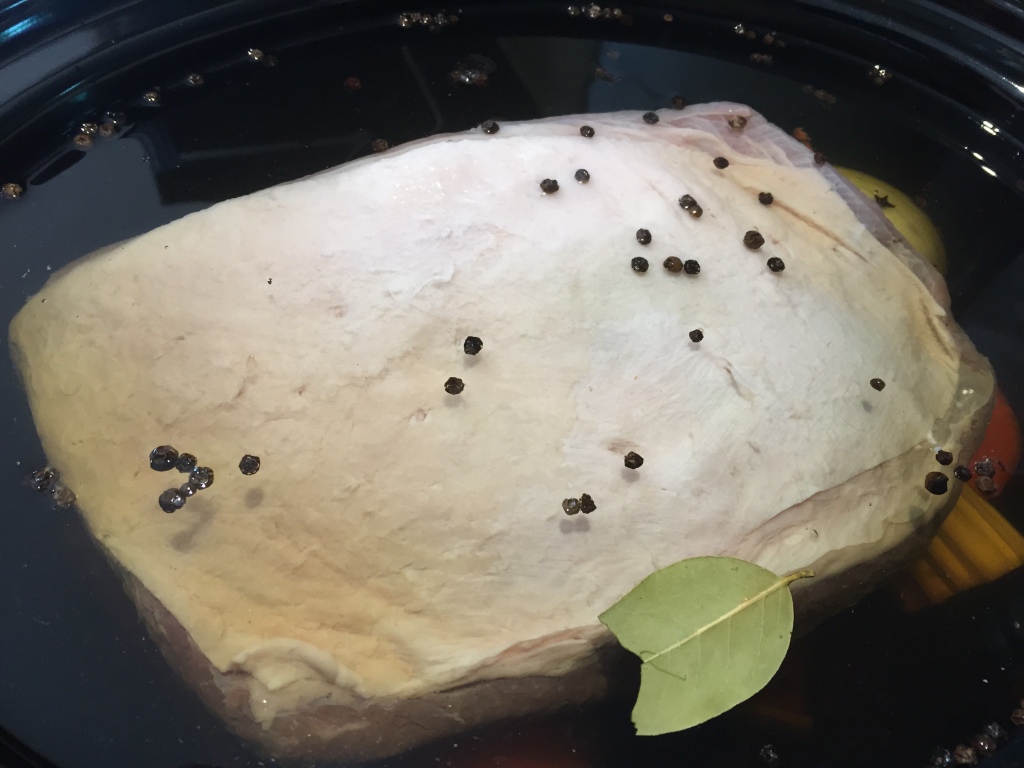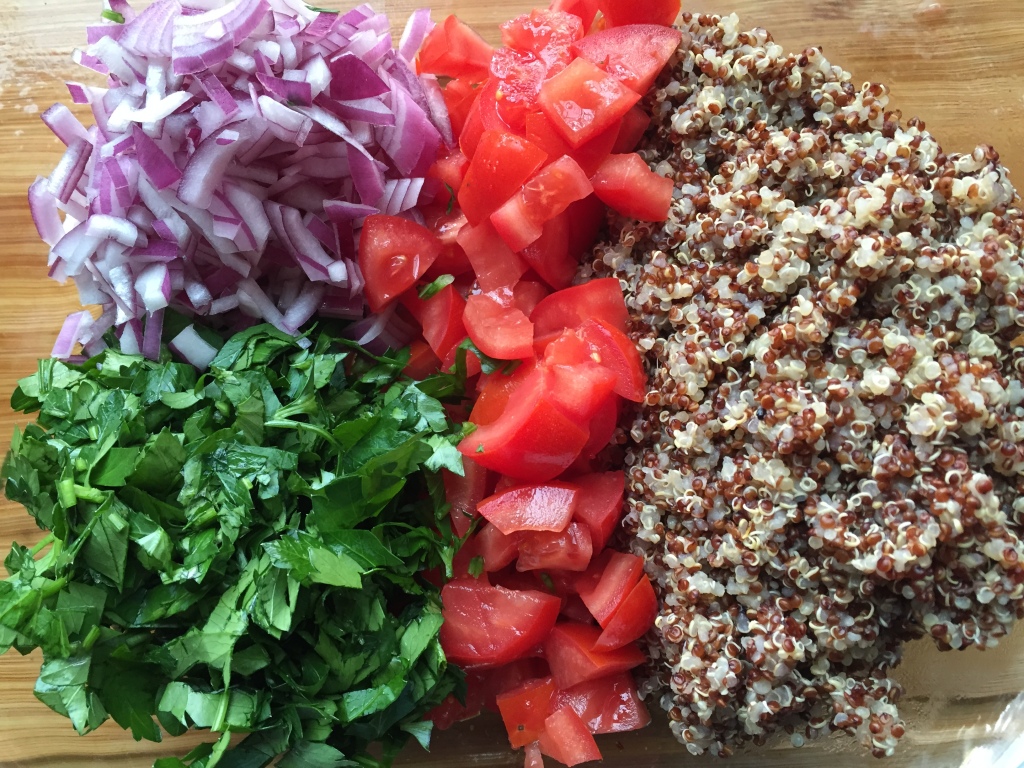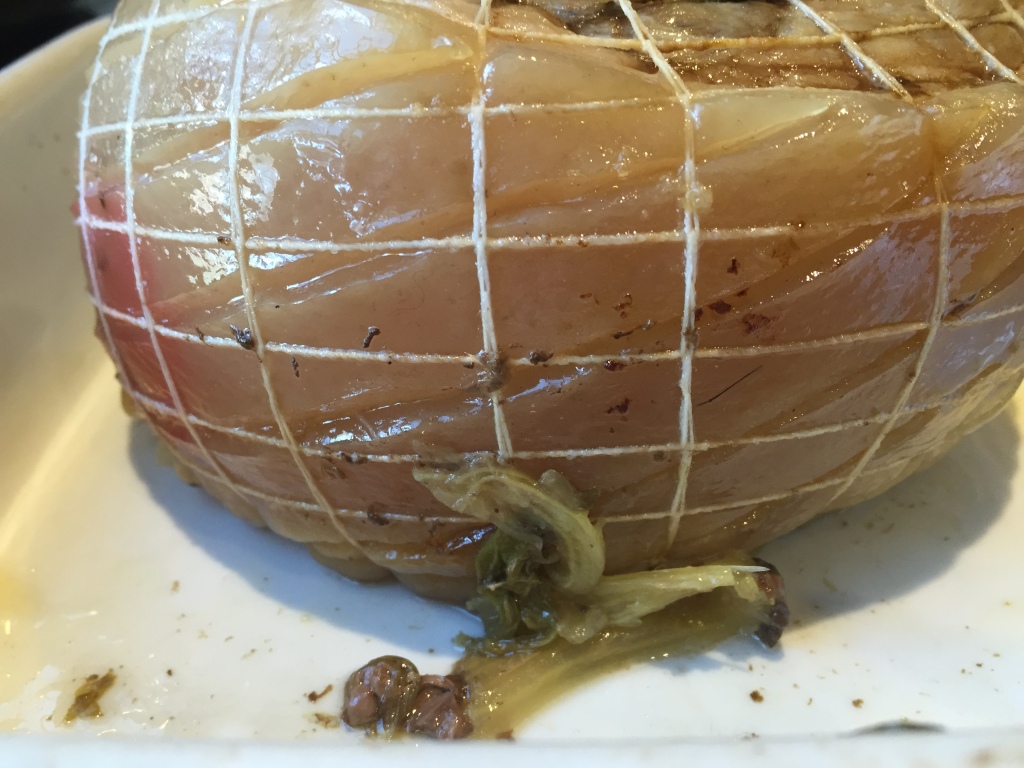Artificial Insemination (AI) can be a touchy subject for ethical meat producers for some reason. I’ve hunted around to find a free-range standard we could sign up to, and the best one I found categorically said that you can’t AI. While I understand that natural matings are clearly a better way to go, as is any natural behaviours, I’m not exactly sure why AI is so taboo. There are clear advantages to being able to control your genetics and to not having to mess with a boar (pigs are painful to keep, but boars are next level painful).
It may be because a lot of farms that AI also use hormone treatments to control their girl’s cycles. That use of hormones is uncool, and also against that standard I found. It’s not something we’d ever consider, but is really very common. Our method involves a bit more intensive husbandry, observance, and record keeping, but it’s also less reliable and more prone to gaps in matings. This is another reason why free-ranged produce is more expensive, and why it absolutely should be more expensive. To do it properly increases the labour involved exponentially, while giving potentially patchier results. Of course, the flipside of that is that it’s better for the animals and the end product is higher quality. That’s why people should be prepared to pay that bit extra for ethically grown meat. But I digress…
While we don’t plan to AI for our production, I have been considering it as a way to breed our replacement gilts. My end-game is to have another property with the bulk of our breeders and growers, while keeping a couple of girls on our home property from which we can breed our replacement girls. Most of the breeding would be done naturally, but I want to breed the replacements using AI. The reasons for this are:
- Keeping a boar just to service two girls once or twice a year is a waste.
- Carting the girls back and forth between properties to get them pregnant is unnecessarily painful.
- Keeping bloodlines separate is difficult. You never want a gilt/sow to be related to the boar servicing her.
Using AI removes all of those problems. We can buy in semen from completely unrelated bloodlines, and can even experiment with the breeds a bit. For example, I’d like to try both my white and my black girls with a Duroc. Buying a Duroc boar in just for that experiment would be expensive and potentially wasteful should we choose to go a different way. Buying in Duroc semen is inexpensive and risk-free.
Basically, I can have my second, larger property with a number of sows and a couple of boars. They’ll do their thing naturally, and everybody will be happy. At the same time, we can expect to have to replace at least a couple of girls a year. I can have my two breeders at home with no boar and they can give me a lazy litter a year each via AI. I can choose the best of the girls from those litters for my replacement breeders, injecting strong, uncrossed bloodlines into my herd, and the excess can be rolled in with the growers. It’s a good, smart plan.
Anyway, all arguments about the ethicality of AI aside, right now we have a gap in our production. This actually highlights one of the problems I alluded to about the potential patchiness of results when doing things naturally. Our boar, Boris, has given us nearly 100 babies. While he’s painful to manage, being a few hundred kilograms of rock-hard, tusked stubbornness, he’s done well as a sire. The problem we face now isn’t his willingness to perform, nor is it our sow’s cycles or ability to take Boris. The problem we have is purely mechanical – Boris is now about an inch too short to make the penis-to-vagina connection. We watch him try like a champ, but he’s not quite getting there. His success in the past was because the girls were a little shorter, or a couple of times we’ve seen them standing in a hole (e.g. their wallow) while he was on the higher ground (literally, definitely not morally). Now I’m no vet, but I’m pretty sure a lack of penetration leads to a lack of pregnancy.
Ultimately we’ll need a new boar. In fact, we’ll probably need a couple once we’re at our target production. I don’t want to get them now though, not until we have the second property.
At the same time, we’re keen to experiment with different breeds to get an idea which will give us the best offspring. To date, our best results were the Blue Merles – the half white, half heritage babies. The offspring were strong, grew well, and the meat was hands-down the best we’ve produced. At the same time, the full-blood Large Blacks we’ve grown on tend to run to fat. I’m thinking that we might be better putting the muscular Durocs over those blacks to see if we can produce something special. The best, and probably really only sensible, way to do that is via AI. We can both experiment with the breeds we use and fill our gap in production at the same time.
Peyton and I went to a local pig farm a few weeks ago with one of the vets in charge of our Herd Health Management program, where the farm staff taught us how to AI. They were amazingly helpful, and the process is surprisingly easy. In addition to that, the guy who owns that pig farm has offered to sell us semen (from a boar, just to be clear) and the catheters necessary to get said semen into our girls. That’s a huge help to us. The genetics in that pig farm are controlled more tightly than you’d realise, and he has a number of his own pure-bred boys on a property in Clare whose only job is to produce the semen he uses on his farm.
We track our sow’s oestrus cycles. We know when they’re in season due to their behaviour, which can vary slightly from girl to girl. Knowing them as well as we do though, we can pick it fairly accurately. To ensure they’re in season all you need to do is push down on their back and rub their flanks. They’ll enjoy a back scratch if they’re not in season, but pushing down on their back will piss them off (it’s analogous to a boar trying to mount them). However, push down on their back while they’re in season and they’ll actually arch into it. It’s pretty obvious once you’ve seen it.
Having the boar there helps too. He may not be getting the angle of the dangle right, but he’s stinky and that really brings out the girl’s oestrus behaviours. It also keeps them calm and standing still during the AI process. They’ll basically go nose-to-nose with the boar while you mess with their bits, and they’ll not fuss at all. This is actually an argument to keep Boris here even if his stubby little legs aren’t up to getting the girls pregnant. It’s not entirely economical or sensible to keep a boar who isn’t working, but we’ll not chop him unless we absolutely have to.

This is Boris’ look of seduction. Works every time.

Boris and Miss Swan whispering sweet nothings to each other.
The process is simple, mainly because of the sow’s physiology. A sow’s cervix interlocks and kind of clamps together. This is exactly why a boar’s penis is shaped and built like a screw – it literally has to drive in. All other mammals deposit sperm in the vaginal cavity, but with pigs the boar’s penis is caught in the sow’s cervix and the sperm is deposited inside the uterus. Pretty cool, right?! Seriously, you should google the process. It’s fascinating. You’ll want to be specific with your search term though, otherwise you might get back some weird results…
There are catheters called “spirettes” which mimic the boar’s penis shape. During the AI you apparently literally have to screw them into the cervix. However, both the vet and the farm we went to prefer gel tipped catheters. With these you just push into until you feel resistance at the cervix, and the gel tip slide between the muscles as they clamp down.
Taking a step back from the cervix, you need to get the catheter to that point first, and that point is a good 12 inches in. The catheter is covered in plastic, which is good because a pig’s nether regions can be grotty and you don’t want to be pushing that grot 12 inches into your sow. You position the tip of the covered catheter against the sow’s vagina, angling down a little. As you push it in, you tear the plastic back so the catheter slips in uncovered. You pull the vulva down so the penetration is clean. Once the tip is in, you “shoot for the stars”, as our vet put it – you push the catheter up at a fairly steep angle. The sow is fine with that as long as the boar is in front of her and you’re not too rough. You feel resistance when the catheter is about 2/3 of the way in, which is the cervix.

Tip in and pushed through the plastic.

Resistance = cervix.
Once the catheter is in position, you break the tip from the tube of semen and insert it into the little adapter at the end of the catheter. You don’t squeeze the tube to deposit the semen. All that will do is force the semen in and potentially have it run out. You may have to squeeze a little to clear an airlock though. Once that’s done, however, the cervix/uterus kind of sucks the semen in. It’s weirdly fascinating. You just hold it up and the sow’s reproductive bits do the work for you.

Time for the semen. The tricky part is not getting any on your fingers. Seriously.
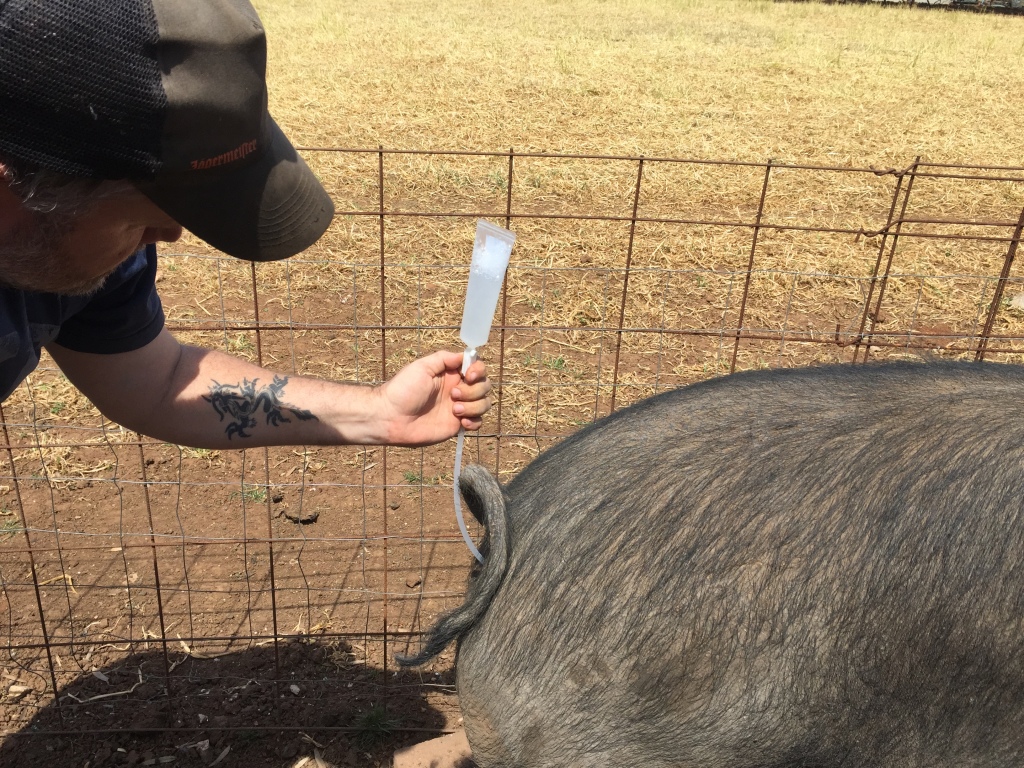
Clear any airlocks and let gravity and the sow’s bits do the rest.
There’s every chance the sow will stand there, nose-to-nose with the boar. If she gets a little antsy you just lean on her back. A combination of the catheter in her, you leaning on her, and the boar’s presence makes her feel like she’s being mounted. The piggery even had a contraption that you could put across their back like a clamp. It mimicked being mounted, and even had a handy dandy arm to hold the semen/catheter. In our case, Miss Swan was super ready and just stood communing with Boris.

The lovers communing while I mess with her bits.
Once it’s all done, and it really should only take a couple of minutes, you disconnect the empty tube. The adaptor at the end of the catheter has a little inbuilt plug that you put in, for reasons that should be obvious. You then just leave her for several minutes to make sure the semen is where it should be.
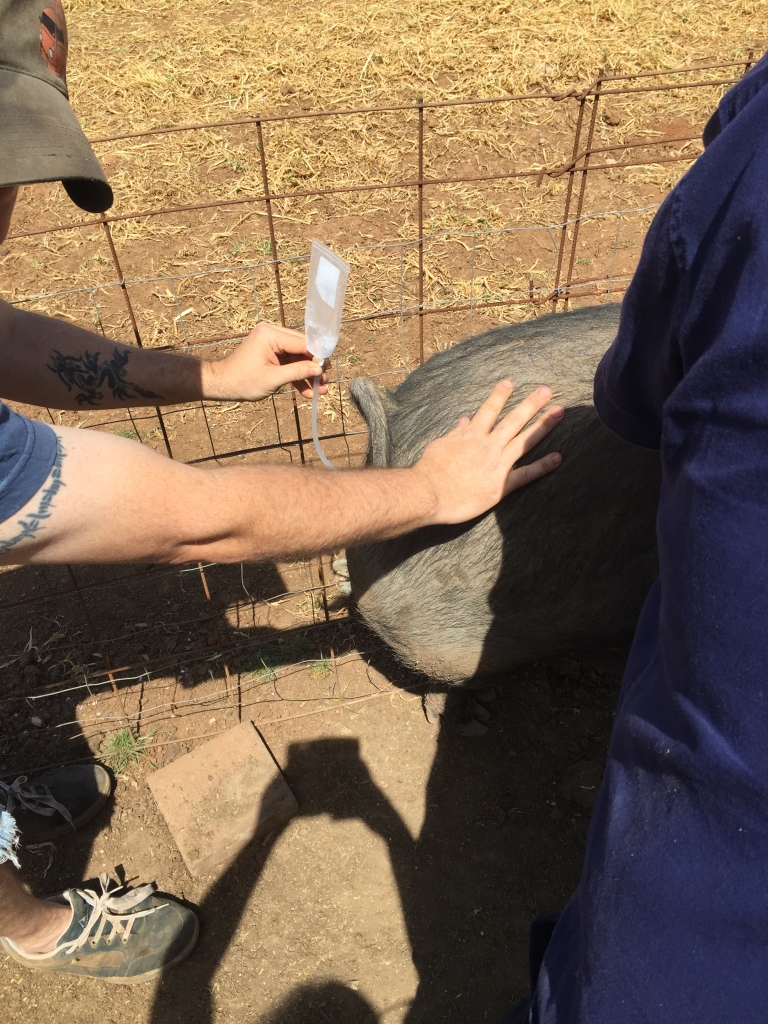
Almost done. This took maybe two minutes.

Disconnect the now empty semen tube, again trying to keep it from your fingers.
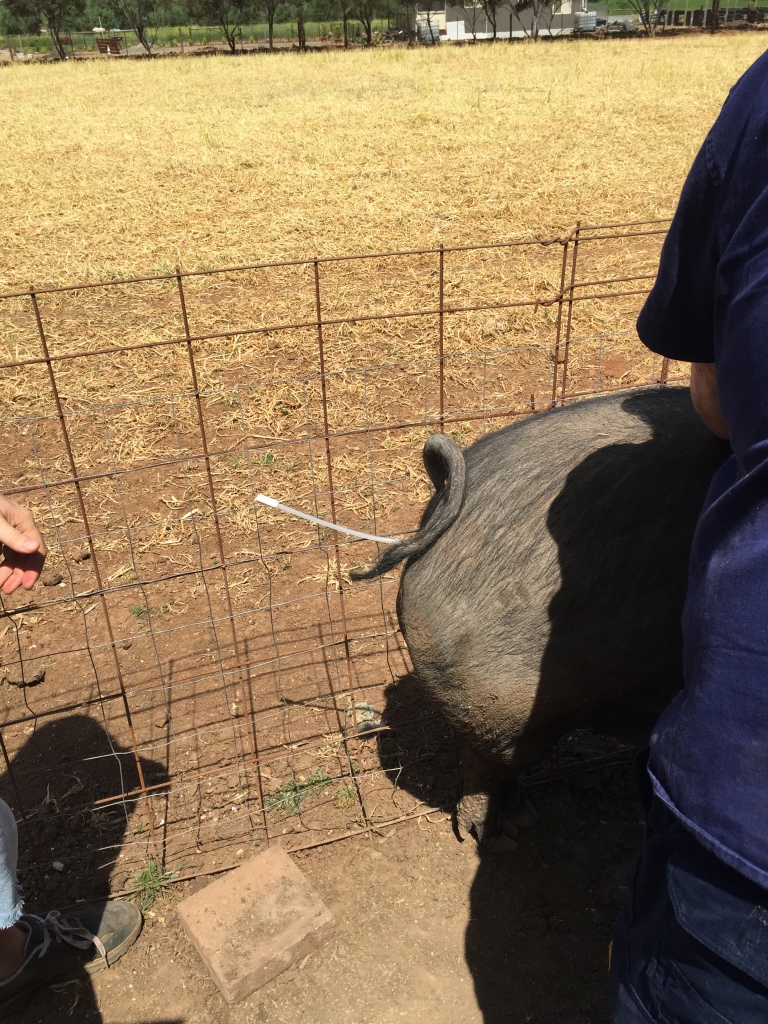
Put the plug in the catheter and let it stay for several minutes.
Again, Miss Swan just stood there the entire time, soaking up some Boris company. Our race wasn’t designed for this, but works very well. At the piggery they used a large-ish pen with four boars along one edge in their own individual pens. The girls came in, chose a boy, and went to chat to him while we AI’d them. That worked well, but they had space to start moving around if they were restless. We even had one girl that wouldn’t stop trying to mount the others. Using our race worked out much better, though it means we’re only doing one at a time, not that we’ll ever really need to do more. The race contained Miss Swan a bit, and kept her facing Boris. That all meant she stood still the whole time, and the entire process was quick and painless.

While Miss Swan stood still for the entire process and communed with the big man, and while she may have gotten everything out of the experience that she wanted, I suspect that Boris was less than satisfied…
A tube of this semen apparently contains 3 billion sperm, where the boar normally deposits around 20 to 60 billion. Clearly 3 billion, while large, is a much smaller number than 20 or 60 billion. However, according to the vet, you can do the job with as few as 1.5 billion if the girl is at the right stage of her oestrus. Miss Swan was obviously ready and I suspect her oestrus started the day prior based on her behaviour. I’m confident that this AI did the job, but we repeat the process the following day, just to make sure.
